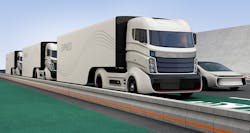Sticking with the theme of disruption and transformation, nothing has the potential to be more disruption in the trucking industry than autonomous vehicles.
At a recent NationaLease meeting, guest speaker John Paul MacDuffie, professor at the Wharton School at the University of Pennsylvania, said that autonomy requires new hardware components and lots of AI software. Engineering talent will be one of the keys to its success along with the ability to get the system integration piece of the equation right. MacDuffie does not see technology firms jumping in to manufacture vehicles but rather, working on developing operating systems for autonomous vehicles.
We are already seeing incremental moves toward autonomy with some of the advanced driver assistance features that are available on trucks today. This includes things like collision mitigation and lane departure systems.
The Society of Automotive Engineers (SAE) has defined six levels of autonomy from zero (no automation) to 5 (full automation). MacDuffie believes there is a big leap in getting from Level 2 autonomy to Level 3.
Level 2, or partial automation, allows steering and acceleration and deceleration to be automated “using information about the driving environment…with the exception that the human driver perform all remaining aspects of the dynamic driving task,” according to the SAE definition. The human driver is tasked with monitoring the driving environment.
In Level 3, or conditional automation, the system monitors the driving environment while the driver will respond appropriately to a request by the system to intervene.
“Level 3 automation is particularly tricky,” MacDuffie said. How to safely transfer control from the computer to the driver, particularly in emergency situations, needs to be worked out. “[There has to be a] balancing act of providing drivers with the benefits of autonomy — like not having to pay attention — while ensuring they are ready to grab the wheel if the [vehicle] encounters something it can’t handle.”
What is likely to happen on the road to autonomous vehicles, according to MacDuffie, is partnerships between truck makers and tech companies — what he calls “partnerships of ‘sky’ and ‘ground.’”
He added, “The winning combination will succeed not just in meeting customer needs/wants, but also societal goals and expectations.”
About the Author
Jane Clark
Senior VP of Operations
Jane Clark is the senior vice president of operations for NationaLease. Prior to joining NationaLease, Jane served as the area vice president for Randstad, one of the nation’s largest recruitment agencies, and before that, she served in management posts with QPS Companies, Pro Staff, and Manpower, Inc.
